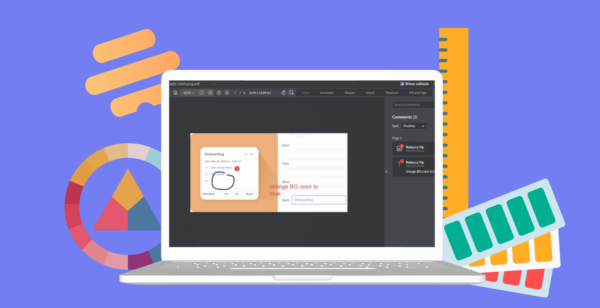If you’re managing a creative team, your challenge is to keep projects on track — but too many rules and too much micromanagement can stifle innovation. This is where creative workflow management comes in, guiding projects toward completion via an organized sequence of assigned tasks.
That way, you can meet key project objectives such as timely delivery and client satisfaction, while giving your creative team the room to, well, be creative. So what are the stages of managing a creative workflow? We’ll explain everything you need to know.
What is creative workflow management?
Let’s rewind for a second — what is a creative workflow? It’s a way of bringing structure to the creative process for a project or campaign by organizing it into a logical sequence of steps, from idea generation to final approval.
Creative workflow management is the process of organizing and supervising this workflow to ensure the project runs smoothly and meets its deadlines. It documents the scope of the project, the timeline, and the resources required, and assigns roles and responsibilities for each task.
As well as streamlining the flow of your project, creative workflow management enables you to keep track of all revisions and approvals, and to share details of the process with stakeholders. Once you’ve created a standardized workflow, it can be adapted to any creative project.

Why is it important?
The creative process can be unwieldy. It’s too easy for creative professionals to get carried away with ideas and inspiration, and head off in a different direction that’s beyond the original scope of the project. This can lead to delays, duplicated work, and arguments within a team.
But with a defined process in place, and with strong management, you can keep the project on track without inhibiting anyone’s creativity. Creative workflow management lets everyone see what tasks need to be done, who is assigned to do them, and when they must be completed by.
Basically, it gives the entire team a roadmap for how the project should move forward. You can build in mini-deadlines or milestones so that tasks are completed in iterations, and set up clear parameters for tracking and measuring progress.
With creative workflow management, you’ll be able to stick to deadlines, meet client expectations, and communicate effectively within the team. It also improves productivity, giving creatives more time to actually create.

6 stages of creative workflow management — and how to master them
We should point out that creative workflow management isn’t a one-size-fits-all thing. Every creative team in every business is different, so your creative workflow process has been developed to suit your needs.
However, the key elements tend to be the same across the board: definition, creation, review, approval, and debrief. Let’s break those down further and explore how to master each stage.
1. Define the scope
The first step toward successful workflow management is to define the scope of the project or campaign. The client you’re working for should have provided the necessary information in their brief or intake form, including their specifications, desired outcomes, budget, and timeline.
You’ll need to take all of this into account when planning the workflow, liaising with the client where necessary. Then consider how you’ll tackle the project and the resources you’ll need to complete it.
In this initial stage, creative brainstorming plays a crucial role in gathering diverse ideas and perspectives, which helps in establishing a comprehensive scope that aligns with the client’s objectives and creative possibilities.
Define the tasks that come within the agreed scope and those that would fall outside it—that way, you can prevent scope creep.

Image sourced from lucidchart.com
How to master it:
It’s vital that you clarify everything with the client, especially if something seems unclear or ambiguous. Make sure you understand their expectations, and that they understand your capabilities. Get them to sign off on this agreement before going any further.
2. Assign key roles
This is a crucial part of creative workflow management, because it avoids confusion, friction, and omission or duplication of tasks. Even if the team is relatively small, assigning roles and responsibilities ensures that everyone is held accountable for their work.
Investing in HR courses for your team can develop their managerial skills and decision-making abilities, essential for key roles that require leadership and strategic oversight.
When you’re assigning the key roles, take into account the strengths and weaknesses of each team member. Who does each one report to? Who’s in charge of the review process? Who is responsible for updating the client on project progress?
How to master it:
By assigning roles and clarifying responsibilities from the get-go, you leave no room for confusion or debate. It’s important that you consider aspects like skill sets and expertise. For example, let’s say you’re creating content to promote a SaaS conference 2024. The right person to head the content team would be someone with in-depth knowledge of the SaaS niche.
3. Map out the new workflow
The next step is to produce a roadmap for managing the creative workflow, based on the project scope information and the roles you’ve assigned. This stage is about establishing the main workflow steps and setting deadlines and milestones to track your progress.
You’ll need to look at your team’s existing workflows and analyze previous projects you’ve completed. Identify which aspects worked and which didn’t. For example, do you need to allow more time for certain tasks? Do you need a better way to track your revisions?
How to master it:
The simplest way to communicate this roadmap to your team and stakeholders is to present it visually. Create a workflow diagram or a flow chart that depicts each stage, the tasks involved, and the overall project timeline. Once this is done, it’s best to make sure your team members are happy with the setup before implementing it.

4. Manage the workflow (and the team)
Once the team gets going on the creative production, the project manager needs to oversee the workflow without micromanaging. Incorporating contract management here ensures that all legal and financial agreements align with the project objectives and are adhered to throughout the workflow.
Utilizing a marketing dashboard to track the time spent by team members on each assigned task is a good way to monitor progress effectively. This dashboard can also help visualize other critical metrics, providing the insights needed to create realistic timelines for future projects.
Since the main aim is to streamline operations, it’s a good idea to use time-saving templates for repeatable tasks such as team scheduling, approval checklists, and client invoices. But it’s worth remembering that the creative process should be dynamic, so you may need to make adjustments to the workflow as you go.
How to master it:
Constant communication, both internal and external, is key to successful management. To ensure smooth team collaboration, you need to facilitate easy communication via multiple channels—including team chat, video calls, and in-person catch-up meetings. Keeping everyone in the loop helps to build trust and camaraderie within the team.
5. Review and approval
When you’re running a project or campaign on a client’s behalf, a robust review and approval process is essential. In fact, there are two processes involved, because you’ll need to carry out internal reviews and approvals before showing work to the client.
Your roadmap should state when these reviews will take place, and who is responsible for each step. For example, who in your team is authorized to approve each project phase, and who will liaise with the client? Put a process in place for getting final approval and sign-off from the client.

Free to use image sourced from Pexels
How to master it:
A big part of the creative process involves getting feedback from clients as the project moves forward, meaning you may need to make adjustments to the product you’re creating. On complex projects, there will be plenty of feedback, so it’s important to have a system for managing and organizing it.
It’s helpful to assign a name or number to each round of feedback and a corresponding one to each revision, so that you can keep track of what you’ve done so far. This ensures accountability on your part and on the client’s and generates a useful audit trail of revisions and approvals.
6. Debriefing
Once the project is complete, the final stage of creative workflow management is to look back at what happened and discuss it as a team. Use the agreed-upon metrics to see if you met the expected standards and targets, and identify areas for improvement. Compare the data from this project with data from previous projects, and check for recurring issues to iron out.
How to master it:
Take a look at the client feedback you received throughout the project, and any feedback from team members. Were there any major problems—and could they have been avoided with a clearer brief from the client or better internal communication? For example, if you were creating marketing material for a B2B tech SEO agency, did you take time to discuss the nuances of B2B with the client?
BONUS TIP: Take advantage of smart tools
Creative workflow management becomes much more efficient if you use the right tools to help you. For instance, you’ll want to automate repetitive tasks, collate client feedback and digital assets from different sources, and communicate via a centralized platform – like Hive!
Nick Brown is the founder & CEO of accelerate agency, the SaaS SEO agency. Nick has launched several successful online businesses, writes for Forbes, published a book and has grown accelerate from a UK-based agency to a company that now operates across US, APAC and EMEA.

